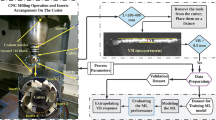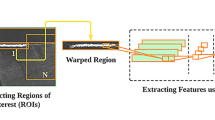Abstract
Machining of Inconel 718 causes rapid tool failure, which affects the tooling cost and dimension tolerance of the components. Literature attributed flank wear as the dominant failure criterion that determines tool life during the milling operation. Flank wear width (VB) can be measured using digital microscopes or predicted in-process by a machine vision-based tool condition monitoring (MV-TCM) system. In MV-TCM, geometric and textural features are extracted from the flank wear region to represent VB progression. However, the leading cutting edge, where flank wear is measured, experiences progressive chipping and built-up edge when machining Inconel 718. These failure modes distract pixel distribution and luminosity, creating complex flank wear features on the leading cutting edge. Nevertheless, the wear region extracted from the side cutting edge shows a consistent change in features that can be used to predict flank wear progression under such failure modes. In addition, the scale-invariant fractal dimension can complement the geometric parameters, improving the reliability of features used to predict flank wear. This paper presents a multi-layer perceptron neural network (MLPNN) that was trained using a synergy of geometric and fractal features extracted from the side cutting edge of square inserts to predict flank wear progression during face milling of Inconel 718. The MLPNN shows an accuracy of 95.5% and a mean absolute percentage error of 1.099% during MV-TCM. The paper shows the potential of applying an in-process MV-TCM expedited by spatial binary features to estimate flank wear progression when milling Inconel 718.










Similar content being viewed by others
References
Polvorosa R, Suárez A, López de Lacalle L.N, Cerrillo I, Wretland A, Veiga F (2017) Tool wear on nickel alloys with different coolant pressures: Comparison of Alloy 718 and Waspaloy. Journal of Manufacturing Processes 26: 44-56. https://doi.org/10.1016/j.jmapro.2017.01.012
Devillez A, Schneider F, Dominiak S, Dudzinski D, Larrouquere D (2007) Cutting forces and wear in dry machining of Inconel 718 with coated carbide tools. Wear 262(7–8):931–942. https://doi.org/10.1016/j.wear.2006.10.009
Anderson M, Patwa R, Shin YC (2006) Laser-assisted machining of Inconel 718 with an economic analysis. Int J Mach Tools Manuf 46(14):1879–1891. https://doi.org/10.1016/j.ijmachtools.2005.11.005
Lins RG, Guerreiro B, Marques De Araujo PR, Schmitt R (2020) In-process tool wear measurement system based on image analysis for CNC drilling machines. IEEE Trans Instrum Meas 69(8):5579–5588. https://doi.org/10.1109/TIM.2019.2961572
Wu X, Liu Y, Zhou X, Mou A (2019) Automatic identification of tool wear based on convolutional neural network in face milling process. Sensors (Switzerland) 19(18). https://doi.org/10.3390/s19183817
Peng R, Pang H, Jiang H, Hu Y (2020) Study of Tool Wear Monitoring Using Machine Vision. Autom Control Comput Sci 54(3):259–270. https://doi.org/10.3103/S0146411620030062
Zhu K (2022) Machine Vision Based Smart Machining System Monitoring. 267–295. https://doi.org/10.1007/978-3-030-87878-8_8
Kamdani K, Hasan S, Farid A, Ashaary IA, Lajis A, Rahim EA (2019) Study on tool wear and wear mechanisms of end milling Nickel-based alloy. Jurnal Tribologi 21: 82-92. https://jurnaltribologi.mytribos.org/v21/JT-21-82-92
Duan G, Chen YW, Sukegawa T (2010) Automatic optical flank wear measurement of microdrills using level set for cutting plane segmentation. Mach Vis Appl 21(5):667–676. https://doi.org/10.1007/s00138-010-0259-y
Contrast-limited adaptive histogram equalization (CLAHE) - MATLAB adapthisteq. https://www.mathworks.com/help/images/ref/adapthisteq.html. Accessed 12 Feb 2022
Campos GFC, Mastelini SM, Aguiar GJ, Mantovani RG, de Melo LF, Barbon S (2019) Machine learning hyperparameter selection for Contrast Limited Adaptive Histogram Equalization. Eurasip J Image Video Process 1:2019. https://doi.org/10.1186/s13640-019-0445-4
Kipli K et al (2018) Morphological and Otsu’s thresholding-based retinal blood vessel segmentation for detection of retinopathy. Int J Eng Technol 7(3):16–20. https://doi.org/10.14419/ijet.v7i3.18.16665
Xiong G, Liu J, Avila A (2011) Cutting tool wear measurement by using active contour model based image processing. In: 2011 IEEE International Conference on Mechatronics and Automation. ICMA 2011, pp 670–675. https://doi.org/10.1109/ICMA.2011.5985741
Sulong G, Abdulaali H, Hassan S (2015) Edge detection algorithms VS-active contour for sketch matching: comparative study. Res J Appl Sci Eng Technol 11(7):759–764. https://doi.org/10.19026/rjaset.11.2038
Thakre AA, Lad AV, Mala K (2019) Measurements of Tool wear parameters using machine vision system. https://doi.org/10.1155/2019/1876489
Castejón M, Alegre E, Barreiro J, Hernández LK (2007) On-line tool wear monitoring using geometric descriptors from digital images. Int J Mach Tools Manuf 47(12–13):1847–1853. https://doi.org/10.1016/j.ijmachtools.2007.04.001
Prasad KN, Ramamoorthy B (2001) Tool wear evaluation by stereo vision and prediction by artificial neural network. J Mater Process Technol 112(1):43–52. https://doi.org/10.1016/S0924-0136(00)00896-7
Loizou J, Tian W, Robertson J, Camelio J (2015) Automated wear characterization for broaching tools based on machine vision systems. J Manuf Syst 37:558–563. https://doi.org/10.1016/j.jmsy.2015.04.005
Zheng G, Zhao J, Li A, Cui X, Zhou Y (2013) Failure mechanisms of graded ceramic tool in ultra high speed dry milling of Inconel 718. Int J Precis Eng Manuf 14(6):943–949. https://doi.org/10.1007/s12541-013-0124-9
Kerr D, Pengilley J, Garwood R (2006) Assessment and visualisation of machine tool wear using computer vision. Int J Adv Manuf Technol 28(7–8):781–791. https://doi.org/10.1007/s00170-004-2420-0
Basirat R, Goshtasbi K, Ahmadi M (2019) Determination of the fractal dimension of the fracture network system using image processing technique. Fractal Fract 3(2):1–9. https://doi.org/10.3390/fractalfract3020017
Moldovan OG, Dzitac S, Moga I, Vesselenyi T, Dzitac I (2017) Tool-wear analysis using image processing of the tool flank. Symmetry (Basel) 9(12):1–18. https://doi.org/10.3390/sym9120296
Schmitt R, Cai Y, Pavim A (2011) Machine Vision System for Inspecting Flank Wear on Cutting Tools. Proc. of Int. Conf. on Advances in Communication and Information Technology 2011. http://citeseerx.ist.psu.edu/viewdoc/download?doi=10.1.1.671.8511&rep=rep1&type=pdf
ISO 8688-1 : 1989 (E) Tool life testing in milling - Part 1 : Face milling. International Organization for Standardization.
Kaya B, Oysu C, Ertunc HM (2011) Advances in Engineering Software Force-torque based on-line tool wear estimation system for CNC milling of Inconel 718 using neural networks. Adv Eng Softw 42(3):76–84. https://doi.org/10.1016/j.advengsoft.2010.12.002
Kasim MS, Che Haron CH, Ghani JA, Sulaiman MA, Yazid MZA (2013) Wear mechanism and notch wear location prediction model in ball nose end milling of Inconel 718. Wear 302(1–2):1171–1179. https://doi.org/10.1016/j.wear.2012.12.040
Reza AM (2004) Realization of the contrast limited adaptive histogram equalization (CLAHE) for real-time image enhancement. J VLSI Signal Process Syst Signal Image Video Technol 38(1):35–44. https://doi.org/10.1023/B:VLSI.0000028532.53893.82
Sreedhar K (2012) Enhancement of images using morphological transformations. Int J Comput Sci Inf Technol 4(1):33–50. https://doi.org/10.5121/ijcsit.2012.4103
Landini G, Randell DA, Fouad S, Galton A (2017) Automatic thresholding from the gradients of region boundaries. J Microsc 265(2):185–195. https://doi.org/10.1111/jmi.12474
Ma X, Li B, Zhang Y, Yan M (2012) The Canny edge detection and its improvement. In: Lecture Notes in Computer Science (including subseries Lecture Notes in Artificial Intelligence and Lecture Notes in Bioinformatics), vol 7530. LNAI, pp 50–58. https://doi.org/10.1007/978-3-642-33478-8_7
Shanmugavadivu P, Sivakumar V (2012) Fractal dimension based texture analysis of digital images. Procedia Engineering 38:2981–2986. https://doi.org/10.1016/j.proeng.2012.06.348
Wu J, Jin X, Mi S, Tang J (2020) An effective method to compute the box-counting dimension based on the mathematical definition and intervals. Results Eng 6(December 2019):100106. https://doi.org/10.1016/j.rineng.2020.100106
Arif J, Chaudhuri NR, Ray S, Chaudhuri B (2009) Online Levenberg-Marquardt algorithm for neural network based estimation and control of power systems. Proc Int Jt Conf Neural Networks 199–206. https://doi.org/10.1109/IJCNN.2009.5179071
Huang W et al (2021) Tool wear in ultrasonic vibration–assisted drilling of CFRP: a comparison with conventional drilling. Int J Adv Manuf Technol 1809–1820. https://doi.org/10.1007/s00170-021-07198-w
Hao Z, Gao D, Fan Y, Han R (2011) New observations on tool wear mechanism in dry machining Inconel718. Int J Mach Tools Manuf 51(12):973–979. https://doi.org/10.1016/j.ijmachtools.2011.08.018
Author information
Authors and Affiliations
Contributions
All authors contributed to the conceptual idea of the manuscript. Materials preparation was done by Dr Chin Seong Lim. Data collection and analysis was performed by Mr. Tiyamike Banda and Dr Veronica Lestari Jauw. The first draft of the manuscript was written by Mr. Tiyamike Banda and all authors commented on the previous versions. All authors read and finally approved the final version of the manuscript.
Corresponding author
Ethics declarations
Competing interests
The authors declare no competing interests.
Additional information
Publisher's Note
Springer Nature remains neutral with regard to jurisdictional claims in published maps and institutional affiliations.
Rights and permissions
About this article
Cite this article
Banda, T., Jauw, V., Li, C. et al. Flank wear prediction using spatial binary properties and artificial neural network in face milling of Inconel 718. Int J Adv Manuf Technol 120, 4387–4401 (2022). https://doi.org/10.1007/s00170-022-09039-w
Received:
Accepted:
Published:
Issue Date:
DOI: https://doi.org/10.1007/s00170-022-09039-w






